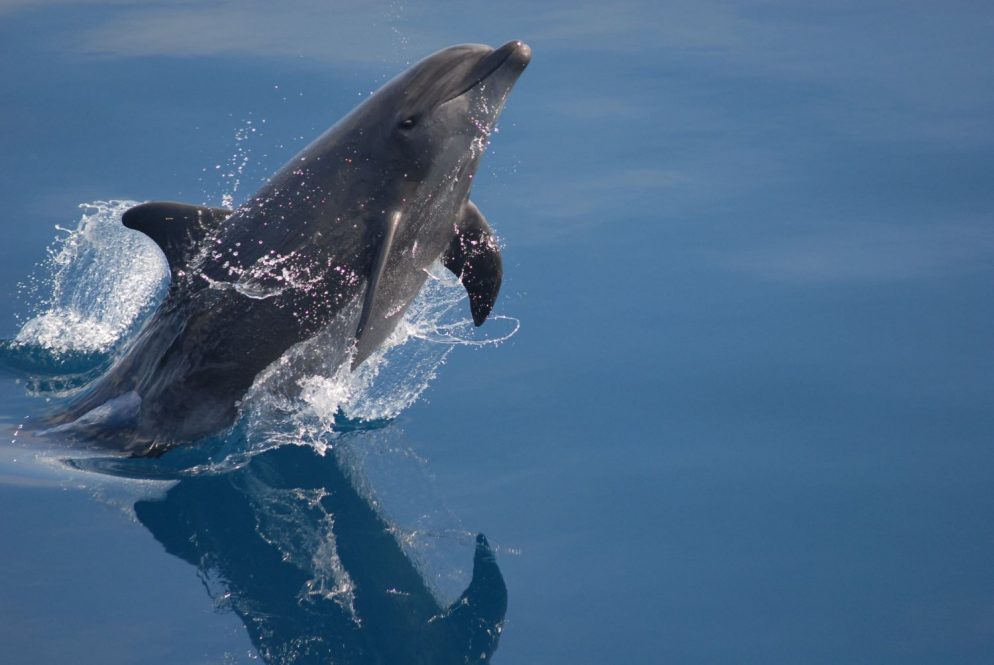When Sylvain De Guise and his friends get together, it’s not at a barbeque or for a game of pickleball. Their reunions happen on research boats.
De Guise, professor of pathobiology and veterinary science within the College of Agriculture, Health and Natural Resources, and his colleagues have been studying dolphin populations in the Southeastern United States for decades. Each summer, they go out onto the water to gather samples and study the dolphins’ health.
“It’s like meeting 80 of your best friends every year at camp,” says De Guise, who is also director of Connecticut Sea Grant. “There’s a camaraderie.”
Much like a human’s annual check-up, one of the key components of evaluating the dolphin’s health is a blood sample.
Now, this group has developed a new and improved way to understand what these samples mean for the health of the entire population. They published their findings in Conservation Biology.
The group sorted through the years and years of data they had collected on hundreds of dolphins to determine which biological signals could tell them the most about a dolphin’s long-term survival.
“We did a retrospective study looking at different populations that were sampled at different times, at different places, for different reasons. That let us see if there were things that were not obvious to us at first that, in hindsight, were predictive of health problems,” De Guise says. “And to determine if those health problems were really problematic, we evaluated if the dolphins we sampled died in later years.”
The researchers found that having high globulins and low alkaline phosphatase reliably predicted a dolphin’s death within two years. Both of these metrics are inflammation markers and hence indicative of immune system stress.
“If you’re consistently assaulted by immune challenges, you keep responding and responding and responding, you generate more immunoglobulins,” De Guise. “That might be a reflection of a long-term stress on your health.”
Notably, these markers are not included in textbook cases of what to look for to predict poor health in dolphins.
“Some things, like high globulins, if we looked at it on its own, it wouldn’t be a major cause for concern,” De Guise says. “But if you look at a model that includes several variables, it is often associated with increases in mortality.”
Traditional markers of immune system stress, like white blood cell count, vary over time, making them less useful in predicting long-term survival.
The model the researchers developed is particularly useful when looking at mortality associated with illness in dolphin populations where environmental catastrophes have taken place.
For example, dolphins living in toxic environments like the Gulf of Mexico, the site of the 2010 Deep Water Horizon oil spill, may suffer chronic health issues that these markers can expose.
But, De Guise notes, the model cannot account for random events like harmful algal blooms which kill dolphins nearly instantly.
“If you evaluated health outcomes for humans, you would be unlikely to capture something in a blood sample that would say you were going to get hit by a bus the next day,” De Guise says. “It’s sort of the dolphin equivalent, which we cannot predict with a blood sample.”
This information may allow researchers to study dolphin health more effectively. By knowing which markers are reliable indicators of mortality, they can use a small blood sample rather than a full physical, which can take an hour per dolphin and involves massive field crews.
“If you were, for example, to collect a little bit of blood, instead of looking at 100 parameters, if you were to look at five, which ones would you pick?” De Guise says. “And we might pick some that are, according to that model, associated with poor health outcomes.”
Researchers are currently developing ways to take small blood samples from dolphins remotely. This would involve using a crossbow-like technology to launch a sampling device at the dolphin.
De Guise compares the device to a diabetes monitor, which collects just a few drops of blood. The device stays on the dolphin for a minute and then falls off.
There are already methods that can take skin and blubber samples in a similar fashion. This method requires just three or four people in a boat, rather than the 80-person effort needed to complete full physicals.
These new technologies would also potentially allow researchers to collect samples from shier dolphins that tend to stay too far away from the boat to be captured for a physical.
“If we were able to validate reliable methods for these health evaluations, we would be able to take a much broader number of samples from a more random subsample of the population. It would improve the model findings and also the interpretation of the findings of the model,” De Guise says.
This work relates to CAHNR’s Strategic Vision area focused on Advancing Adaptation and Resilience in a Changing Climate.
Follow UConn CAHNR on social media



